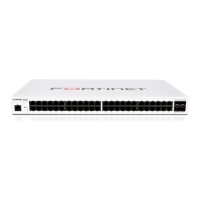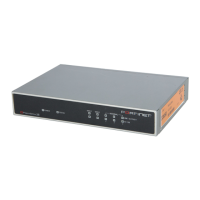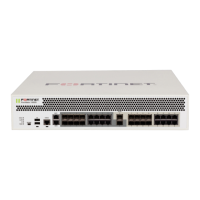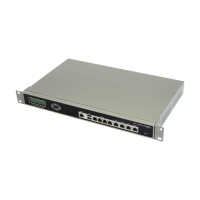FortiGate Version 3.0 MR4 Administration Guide
204 01-30004-0203-20070102
Multicast Router Dynamic
Multicast
A FortiGate unit can operate as a Protocol Independent Multicast (PIM) version 2
router in the root virtual domain. FortiGate units support PIM sparse mode (RFC
2362) and PIM dense mode (RFC 3973) and can service multicast servers or
receivers on the network segment to which a FortiGate interface is connected.
Multicast server applications use a (Class D) multicast address to send one copy
of a packet to a group of receivers. The PIM routers throughout the network
ensure that only one copy of the packet is forwarded through the network until it
reaches an end-point destination. At the end-point destination, copies of the
packet are made only when required to deliver the information to multicast client
applications that request traffic destined for the multicast address.
A PIM domain is a logical area comprising a number of contiguous networks. The
domain contains at least one Boot Strap Router (BSR). If sparse mode is enabled,
the domain also contains a number of Rendezvous Points (RPs) and Designated
Routers (DRs). When PIM is enabled on a FortiGate unit, the FortiGate unit can
perform any of these functions at any time as configured. If required for sparse
mode operation, you can define static RPs.
Viewing and editing multicast settings
When multicast (PIM) routing is enabled, you can configure sparse mode or dense
mode operation on any FortiGate interface.
Networks The IP addresses and network masks of networks to advertise to BGP
peers. The FortiGate unit may have a physical or VLAN interface
connected to those networks.
IP/Netmask Enter the IP address and netmask of the network to be
advertised.
Add Select to add the network information to the Networks list.
Network The IP addresses and network masks of major networks that
are advertised to BGP peers.
Delete icon Select to delete a BGP neighbor entry or a BGP network definition.
Note: To support PIM communications, the sending/receiving applications and all
connecting PIM routers in between must be enabled with PIM version 2. PIM can use static
routes, RIP, OSPF, or BGP to forward multicast packets to their destinations. To enable
source-to-destination packet delivery, either sparse mode or dense mode must be enabled
on all the PIM-router interfaces. Sparse mode routers cannot send multicast messages to
dense mode routers. In addition, if a FortiGate unit is located between a source and a PIM
router, two PIM routers, or is connected directly to a receiver, you must create a firewall
policy manually to pass encapsulated (multicast) packets or decapsulated data (IP traffic)
between the source and destination.
Note: Basic options can be configured through the web-based manager. Many additional
options may be configured through CLI commands only. For complete descriptions and
examples of how to use CLI commands to configure PIM settings, see “multicast” in the
“router” chapter of the FortiGate CLI Reference.

